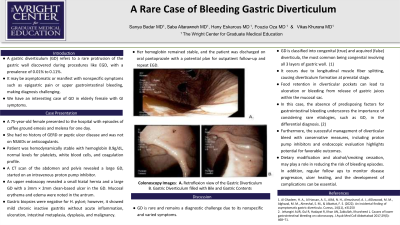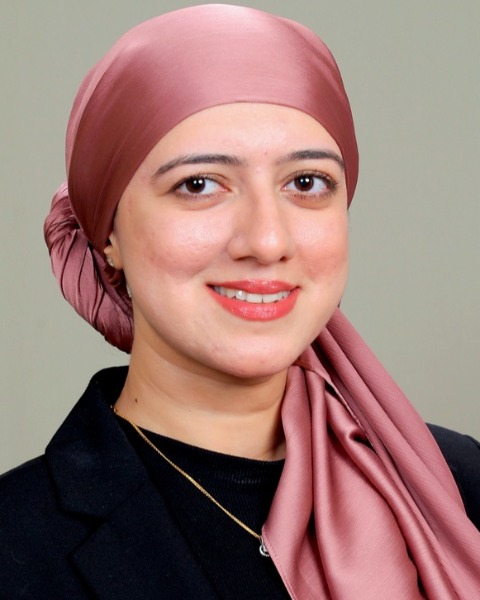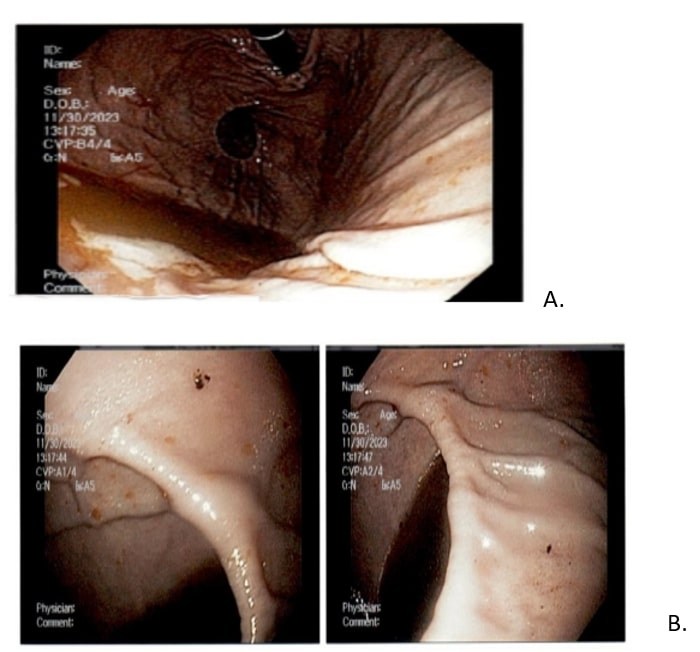Monday Poster Session
Category: GI Bleeding
P2484 - A Rare Case of Bleeding Gastric Diverticulum
Monday, October 28, 2024
10:30 AM - 4:00 PM ET
Location: Exhibit Hall E

Has Audio

Sanya Badar, MD
The Wright Center for Graduate Medical Education
Scranton, PA
Presenting Author(s)
Sanya Badar, MD1, Saba Altarawneh, MD1, Hany Eskarous, MD2, Fouzia Oza, MD1, Vikas Khurana, MD1
1The Wright Center for Graduate Medical Education, Scranton, PA; 2The Wright Center for Graduate Medical Education, Dunmore, PA
Introduction: A gastric diverticulum (GD) refers to a rare protrusion of the gastric wall discovered during procedures like EGD, with a prevalence of 0.01% to 0.11%. It may be asymptomatic or manifest with nonspecific symptoms such as epigastric pain or upper gastrointestinal bleeding, making diagnosis challenging. We have an interesting case of GD in elderly female with GI symptoms.
Case Description/Methods: A 75-year-old female presented to the hospital with episodes of coffee ground emesis and melena for one day. She had no history of GERD or peptic ulcer disease and was not on NSAIDs or anticoagulants. Patient was hemodynamically stable with hemoglobin 8.9g/dL, normal levels for platelets, white blood cells, and coagulation profile. A CT scan of the abdomen and pelvis revealed a large GD, started on an intravenous proton pump inhibitor. An upper endoscopy revealed a small hiatal hernia and a large GD with a 3mm × 2mm clean-based ulcer in the GD. Mucosal erythema and edema were noted in the antrum. Gastric biopsies were negative for H. pylori; however, it showed mild chronic inactive gastritis without acute inflammation, ulceration, intestinal metaplasia, dysplasia, and malignancy. Her hemoglobin remained stable, and the patient was discharged on oral pantoprazole with a potential plan for outpatient follow-up and repeat EGD.
Discussion: GD is rare and remains a diagnostic challenge due to its nonspecific and varied symptoms. GD is classified into congenital (true) and acquired (false) diverticula, the most common being congenital involving all 3 layers of gastric wall. It occurs due to longitudinal muscle fiber splitting, causing diverticulum formation at prenatal stage. Food retention in diverticular pockets can lead to ulceration or bleeding from release of gastric juices within the mucosal sac. In this case, the absence of predisposing factors for gastrointestinal bleeding underscores the importance of considering rare etiologies, such as GD, in the differential diagnosis. Furthermore, the successful management of diverticular bleed with conservative measures, including proton pump inhibitors and endoscopic evaluation highlights potential for favorable outcomes. Dietary modification and alcohol/smoking cessation, may play a role in reducing the risk of bleeding episodes. In addition, regular follow ups to monitor disease progression, ulcer healing, and the development of complications can be essential.

Disclosures:
Sanya Badar, MD1, Saba Altarawneh, MD1, Hany Eskarous, MD2, Fouzia Oza, MD1, Vikas Khurana, MD1. P2484 - A Rare Case of Bleeding Gastric Diverticulum, ACG 2024 Annual Scientific Meeting Abstracts. Philadelphia, PA: American College of Gastroenterology.
1The Wright Center for Graduate Medical Education, Scranton, PA; 2The Wright Center for Graduate Medical Education, Dunmore, PA
Introduction: A gastric diverticulum (GD) refers to a rare protrusion of the gastric wall discovered during procedures like EGD, with a prevalence of 0.01% to 0.11%. It may be asymptomatic or manifest with nonspecific symptoms such as epigastric pain or upper gastrointestinal bleeding, making diagnosis challenging. We have an interesting case of GD in elderly female with GI symptoms.
Case Description/Methods: A 75-year-old female presented to the hospital with episodes of coffee ground emesis and melena for one day. She had no history of GERD or peptic ulcer disease and was not on NSAIDs or anticoagulants. Patient was hemodynamically stable with hemoglobin 8.9g/dL, normal levels for platelets, white blood cells, and coagulation profile. A CT scan of the abdomen and pelvis revealed a large GD, started on an intravenous proton pump inhibitor. An upper endoscopy revealed a small hiatal hernia and a large GD with a 3mm × 2mm clean-based ulcer in the GD. Mucosal erythema and edema were noted in the antrum. Gastric biopsies were negative for H. pylori; however, it showed mild chronic inactive gastritis without acute inflammation, ulceration, intestinal metaplasia, dysplasia, and malignancy. Her hemoglobin remained stable, and the patient was discharged on oral pantoprazole with a potential plan for outpatient follow-up and repeat EGD.
Discussion: GD is rare and remains a diagnostic challenge due to its nonspecific and varied symptoms. GD is classified into congenital (true) and acquired (false) diverticula, the most common being congenital involving all 3 layers of gastric wall. It occurs due to longitudinal muscle fiber splitting, causing diverticulum formation at prenatal stage. Food retention in diverticular pockets can lead to ulceration or bleeding from release of gastric juices within the mucosal sac. In this case, the absence of predisposing factors for gastrointestinal bleeding underscores the importance of considering rare etiologies, such as GD, in the differential diagnosis. Furthermore, the successful management of diverticular bleed with conservative measures, including proton pump inhibitors and endoscopic evaluation highlights potential for favorable outcomes. Dietary modification and alcohol/smoking cessation, may play a role in reducing the risk of bleeding episodes. In addition, regular follow ups to monitor disease progression, ulcer healing, and the development of complications can be essential.

Figure: A. Retroflexion view of the Gastric Diverticulum
B. Gastric Diverticulum filled with Bile and Gastric Contents
B. Gastric Diverticulum filled with Bile and Gastric Contents
Disclosures:
Sanya Badar indicated no relevant financial relationships.
Saba Altarawneh indicated no relevant financial relationships.
Hany Eskarous indicated no relevant financial relationships.
Fouzia Oza indicated no relevant financial relationships.
Vikas Khurana indicated no relevant financial relationships.
Sanya Badar, MD1, Saba Altarawneh, MD1, Hany Eskarous, MD2, Fouzia Oza, MD1, Vikas Khurana, MD1. P2484 - A Rare Case of Bleeding Gastric Diverticulum, ACG 2024 Annual Scientific Meeting Abstracts. Philadelphia, PA: American College of Gastroenterology.
